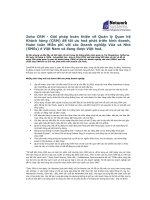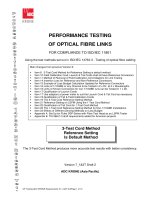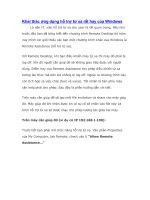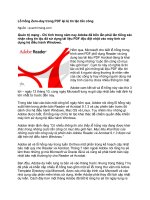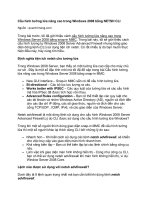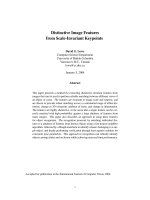Tài liệu Distinctive Image Features from Scale-Invariant Keypoints David G. Lowe Computer Science Department ppt
Bạn đang xem bản rút gọn của tài liệu. Xem và tải ngay bản đầy đủ của tài liệu tại đây (583.97 KB, 28 trang )
Distinctive Image Features
from Scale-Invariant Keypoints
David G. Lowe
Computer Science Department
University of British Columbia
Vancouver, B.C., Canada
January 5, 2004
Abstract
This paper presents a method for extracting distinctive invariant features from
images that can be used to perform reliable matching between different views of
an object or scene. The features are invariant to image scale and rotation, and
are shown to provide robust matching across a a substantial range of affine dis-
tortion, change in 3D viewpoint, addition of noise, and change in illumination.
The features are highly distinctive, in the sense that a single feature can be cor-
rectly matched with high probability against a large database of features from
many images. This paper also describes an approach to using these features
for object recognition. The recognition proceeds by matching individual fea-
tures to a database of features from known objects using a fast nearest-neighbor
algorithm, followed by a Hough transform to identify clusters belonging to a sin-
gle object, and finally performing verification through least-squares solution for
consistent pose parameters. This approach to recognition can robustly identify
objects among clutter and occlusion while achieving near real-time performance.
Accepted for publication in the
International Journal of Computer Vision,
2004.
1
1 Introduction
Image matching is a fundamental aspect of many problems in computer vision, including
object or scene recognition, solving for 3D structure from multiple images, stereo correspon-
dence, and motion tracking. This paper describes image features that have many properties
that make them suitable for matching differing images of an object or scene. The features are
invariant to image scaling and rotation, and partially invariant to change in illumination and
3D camera viewpoint. They are well localized in both the spatial and frequency domains, re-
ducing the probability of disruption by occlusion, clutter, or noise. Large numbers of features
can be extracted from typical images with efficient algorithms. In addition, the features are
highly distinctive, which allows a single feature to be correctly matched with high probability
against a large database of features, providing a basis for object and scene recognition.
The cost of extracting these features is minimized by taking a cascade filtering approach,
in which the more expensive operations are applied only at locations that pass an initial test.
Following are the major stages of computation used to generate the set of image features:
1. Scale-space extrema detection: The first stage of computation searches over all scales
and image locations. It is implemented efficiently by using a difference-of-Gaussian
function to identify potential interest points that are invariant to scale and orientation.
2. Keypoint localization: At each candidate location, a detailed model is fit to determine
location and scale. Keypoints are selected based on measures of their stability.
3. Orientation assignment: One or more orientations are assigned to each keypoint lo-
cation based on local image gradient directions. All future operations are performed
on image data that has been transformed relative to the assigned orientation, scale, and
location for each feature, thereby providing invariance to these transformations.
4. Keypoint descriptor: The local image gradients are measured at the selected scale
in the region around each keypoint. These are transformed into a representation that
allows for significant levels of local shape distortion and change in illumination.
This approach has been named the Scale Invariant Feature Transform (SIFT), as it transforms
image data into scale-invariant coordinates relative to local features.
An important aspect of this approach is that it generates large numbers of features that
densely cover the image over the full range of scales and locations. A typical image of size
500x500 pixels will give rise to about 2000 stable features (although this number depends on
both image content and choices for various parameters). The quantity of features is partic-
ularly important for object recognition, where the ability to detect small objects in cluttered
backgrounds requires that at least 3 features be correctly matched from each object for reli-
able identification.
For image matching and recognition, SIFT features are first extracted from a set of ref-
erence images and stored in a database. A new image is matched by individually comparing
each feature from the new image to this previous database and finding candidate match-
ing features based on Euclidean distance of their feature vectors. This paper will discuss
fast nearest-neighbor algorithms that can perform this computation rapidly against large
databases.
The keypoint descriptors are highly distinctive, which allows a single feature to find its
correct match with good probability in a large database of features. However, in a cluttered
2
image, many features from the background will not have any correct match in the database,
giving rise to many false matches in addition to the correct ones. The correct matches can
be filtered from the full set of matches by identifying subsets of keypoints that agree on the
object and its location, scale, and orientation in the new image. The probability that several
features will agree on these parameters by chance is much lower than the probability that
any individual feature match will be in error. The determination of these consistent clusters
can be performed rapidly by using an efficient hash table implementation of the generalized
Hough transform.
Each cluster of 3 or more features that agree on an object and its pose is then subject
to further detailed verification. First, a least-squared estimate is made for an affine approxi-
mation to the object pose. Any other image features consistent with this pose are identified,
and outliers are discarded. Finally, a detailed computation is made of the probability that a
particular set of features indicates the presence of an object, given the accuracy of fit and
number of probable false matches. Object matches that pass all these tests can be identified
as correct with high confidence.
2 Related research
The development of image matching by using a set of local interest points can be traced back
to the work of Moravec (1981) on stereo matching using a corner detector. The Moravec
detector was improved by Harris and Stephens (1988) to make it more repeatable under small
image variations and near edges. Harris also showed its value for efficient motion tracking
and 3D structure from motion recovery (Harris, 1992), and the Harris corner detector has
since been widely used for many other image matching tasks. While these feature detectors
are usually called corner detectors, they are not selecting just corners, but rather any image
location that has large gradients in all directions at a predetermined scale.
The initial applications were to stereo and short-range motion tracking, but the approach
was later extended to more difficult problems. Zhang et al. (1995) showed that it was possi-
ble to match Harris corners over a large image range by using a correlation window around
each corner to select likely matches. Outliers were then removed by solving for a funda-
mental matrix describing the geometric constraints between the two views of rigid scene and
removing matches that did not agree with the majority solution. At the same time, a similar
approach was developed by Torr (1995) for long-range motion matching, in which geometric
constraints were used to remove outliers for rigid objects moving within an image.
The ground-breaking work of Schmid and Mohr (1997) showed that invariant local fea-
ture matching could be extended to general image recognition problems in which a feature
was matched against a large database of images. They also used Harris corners to select
interest points, but rather than matching with a correlation window, they used a rotationally
invariant descriptor of the local image region. This allowed features to be matched under
arbitrary orientation change between the two images. Furthermore, they demonstrated that
multiple feature matches could accomplish general recognition under occlusion and clutter
by identifying consistent clusters of matched features.
The Harris corner detector is very sensitive to changes in image scale, so it does not
provide a good basis for matching images of different sizes. Earlier work by the author
(Lowe, 1999) extended the local feature approach to achieve scale invariance. This work
also described a new local descriptor that provided more distinctive features while being less
3
sensitive to local image distortions such as 3D viewpoint change. This current paper provides
a more in-depth development and analysis of this earlier work, while also presenting a number
of improvements in stability and feature invariance.
There is a considerable body of previous research on identifying representations that are
stable under scale change. Some of the first work in this area was by Crowley and Parker
(1984), who developed a representation that identified peaks and ridges in scale space and
linked these into a tree structure. The tree structure could then be matched between images
with arbitrary scale change. More recent work on graph-based matching by Shokoufandeh,
Marsic and Dickinson (1999) provides more distinctive feature descriptors using wavelet co-
efficients. The problem of identifying an appropriate and consistent scale for feature detection
has been studied in depth by Lindeberg (1993, 1994). He describes this as a problem of scale
selection, and we make use of his results below.
Recently, there has been an impressive body of work on extending local features to be
invariant to full affine transformations (Baumberg, 2000; Tuytelaars and Van Gool, 2000;
Mikolajczyk and Schmid, 2002; Schaffalitzky and Zisserman, 2002; Brown and Lowe, 2002).
This allows for invariant matching to features on a planar surface under changes in ortho-
graphic 3D projection, in most cases by resampling the image in a local affine frame. How-
ever, none of these approaches are yet fully affine invariant, as they start with initial feature
scales and locations selected in a non-affine-invariant manner due to the prohibitive cost of
exploring the full affine space. The affine frames are are also more sensitive to noise than
those of the scale-invariant features, so in practice the affine features have lower repeatability
than the scale-invariant features unless the affine distortion is greater than about a 40 degree
tilt of a planar surface (Mikolajczyk, 2002). Wider affine invariance may not be important for
many applications, as training views are best taken at least every 30 degrees rotation in view-
point (meaning that recognition is within 15 degrees of the closest training view) in order to
capture non-planar changes and occlusion effects for 3D objects.
While the method to be presented in this paper is not fully affine invariant, a different
approach is used in which the local descriptor allows relative feature positions to shift signif-
icantly with only small changes in the descriptor. This approach not only allows the descrip-
tors to be reliably matched across a considerable range of affine distortion, but it also makes
the features more robust against changes in 3D viewpoint for non-planar surfaces. Other
advantages include much more efficient feature extraction and the ability to identify larger
numbers of features. On the other hand, affine invariance is a valuable property for matching
planar surfaces under very large view changes, and further research should be performed on
the best ways to combine this with non-planar 3D viewpoint invariance in an efficient and
stable manner.
Many other feature types have been proposed for use in recognition, some of which could
be used in addition to the features described in this paper to provide further matches under
differing circumstances. One class of features are those that make use of image contours or
region boundaries, which should make them less likely to be disrupted by cluttered back-
grounds near object boundaries. Matas et al., (2002) have shown that their maximally-stable
extremal regions can produce large numbers of matching features with good stability. Miko-
lajczyk et al., (2003) have developed a new descriptor that uses local edges while ignoring
unrelated nearby edges, providing the ability to find stable features even near the boundaries
of narrow shapes superimposed on background clutter. Nelson and Selinger (1998) have
shown good results with local features based on groupings of image contours. Similarly,
4
Pope and Lowe (2000) used features based on the hierarchical grouping of image contours,
which are particularly useful for objects lacking detailed texture.
The history of research on visual recognition contains work on a diverse set of other
image properties that can be used as feature measurements. Carneiro and Jepson (2002)
describe phase-based local features that represent the phase rather than the magnitude of local
spatial frequencies, which is likely to provide improved invariance to illumination. Schiele
and Crowley (2000) have proposed the use of multidimensional histograms summarizing the
distribution of measurements within image regions. This type of feature may be particularly
useful for recognition of textured objects with deformable shapes. Basri and Jacobs (1997)
have demonstrated the value of extracting local region boundaries for recognition. Other
useful properties to incorporate include color, motion, figure-ground discrimination, region
shape descriptors, and stereo depth cues. The local feature approach can easily incorporate
novel feature types because extra features contribute to robustness when they provide correct
matches, but otherwise do little harm other than their cost of computation. Therefore, future
systems are likely to combine many feature types.
3 Detection of scale-space extrema
As described in the introduction, we will detect keypoints using a cascade filtering approach
that uses efficient algorithms to identify candidate locations that are then examined in further
detail. The first stage of keypoint detection is to identify locations and scales that can be
repeatably assigned under differing views of the same object. Detecting locations that are
invariant to scale change of the image can be accomplished by searching for stable features
across all possible scales, using a continuous function of scale known as scale space (Witkin,
1983).
It has been shown by Koenderink (1984) and Lindeberg (1994) that under a variety of
reasonable assumptions the only possible scale-space kernel is the Gaussian function. There-
fore, the scale space of an image is defined as a function, L(x, y, σ), that is produced from
the convolution of a variable-scale Gaussian, G(x, y, σ), with an input image, I(x, y):
L(x, y, σ) = G(x, y, σ) ∗ I(x, y),
where ∗ is the convolution operation in x and y, and
G(x, y, σ) =
1
2πσ
2
e
−(x
2
+y
2
)/2σ
2
.
To efficiently detect stable keypoint locations in scale space, we have proposed (Lowe, 1999)
using scale-space extrema in the difference-of-Gaussian function convolved with the image,
D(x, y, σ), which can be computed from the difference of two nearby scales separated by a
constant multiplicative factor k:
D(x, y, σ) = (G(x, y, kσ) − G(x, y, σ)) ∗ I(x, y)
= L(x, y, kσ) − L(x, y, σ). (1)
There are a number of reasons for choosing this function. First, it is a particularly efficient
function to compute, as the smoothed images, L, need to be computed in any case for scale
space feature description, and D can therefore be computed by simple image subtraction.
5
Scale
(first
octave)
Scale
(next
octave)
Gaussian
Difference of
Gaussian (DOG)
. . .
Figure 1: For each octave of scale space, the initial image is repeatedly convolved with Gaussians to
produce the set of scale space images shown on the left. Adjacent Gaussian images are subtracted
to produce the difference-of-Gaussian images on the right. After each octave, the Gaussian image is
down-sampled by a factor of 2, and the process repeated.
In addition, the difference-of-Gaussian function provides a close approximation to the
scale-normalized Laplacian of Gaussian, σ
2
∇
2
G, as studied by Lindeberg (1994). Lindeberg
showed that the normalization of the Laplacian with the factor σ
2
is required for true scale
invariance. In detailed experimental comparisons, Mikolajczyk (2002) found that the maxima
and minima of σ
2
∇
2
G produce the most stable image features compared to a range of other
possible image functions, such as the gradient, Hessian, or Harris corner function.
The relationship between D and σ
2
∇
2
G can be understood from the heat diffusion equa-
tion (parameterized in terms of σ rather than the more usual t = σ
2
):
∂G
∂σ
= σ∇
2
G.
From this, we see that ∇
2
G can be computed from the finite difference approximation to
∂G/∂σ, using the difference of nearby scales at kσ and σ:
σ∇
2
G =
∂G
∂σ
≈
G(x, y, kσ) − G(x, y, σ)
kσ − σ
and therefore,
G(x, y, kσ) − G(x, y, σ) ≈ (k − 1)σ
2
∇
2
G.
This shows that when the difference-of-Gaussian function has scales differing by a con-
stant factor it already incorporates the σ
2
scale normalization required for the scale-invariant
6
Scale
Figure 2: Maxima and minima of the difference-of-Gaussian images are detected by comparing a
pixel (marked with X) to its 26 neighbors in 3x3 regions at the current and adjacent scales (marked
with circles).
Laplacian. The factor (k − 1) in the equation is a constant over all scales and therefore does
not influence extrema location. The approximation error will go to zero as k goes to 1, but
in practice we have found that the approximation has almost no impact on the stability of
extrema detection or localization for even significant differences in scale, such as k =
√
2.
An efficient approach to construction of D(x, y, σ) is shown in Figure 1. The initial
image is incrementally convolved with Gaussians to produce images separated by a constant
factor k in scale space, shown stacked in the left column. We choose to divide each octave
of scale space (i.e., doubling of σ) into an integer number, s, of intervals, so k = 2
1/s
.
We must produce s + 3 images in the stack of blurred images for each octave, so that final
extrema detection covers a complete octave. Adjacent image scales are subtracted to produce
the difference-of-Gaussian images shown on the right. Once a complete octave has been
processed, we resample the Gaussian image that has twice the initial value of σ (it will be 2
images from the top of the stack) by taking every second pixel in each row and column. The
accuracy of sampling relative to σ is no different than for the start of the previous octave,
while computation is greatly reduced.
3.1 Local extrema detection
In order to detect the local maxima and minima of D(x, y, σ), each sample point is compared
to its eight neighbors in the current image and nine neighbors in the scale above and below
(see Figure 2). It is selected only if it is larger than all of these neighbors or smaller than all
of them. The cost of this check is reasonably low due to the fact that most sample points will
be eliminated following the first few checks.
An important issue is to determine the frequency of sampling in the image and scale do-
mains that is needed to reliably detect the extrema. Unfortunately, it turns out that there is
no minimum spacing of samples that will detect all extrema, as the extrema can be arbitrar-
ily close together. This can be seen by considering a white circle on a black background,
which will have a single scale space maximum where the circular positive central region of
the difference-of-Gaussian function matches the size and location of the circle. For a very
elongated ellipse, there will be two maxima near each end of the ellipse. As the locations of
maxima are a continuous function of the image, for some ellipse with intermediate elongation
there will be a transition from a single maximum to two, with the maxima arbitrarily close to
7
0
20
40
60
80
100
1 2 3 4 5 6 7 8
Repeatability (%)
Number of scales sampled per octave
Matching location and scale
Nearest descriptor in database
500
1000
1500
2000
2500
3000
3500
1 2 3 4 5 6 7 8
Number of keypoints per image
Number of scales sampled per octave
Total number of keypoints
Nearest descriptor in database
Figure 3: The top line of the first graph shows the percent of keypoints that are repeatably detected at
the same location and scale in a transformed image as a function of the number of scales sampled per
octave. The lower line shows the percent of keypoints that have their descriptors correctly matched to
a large database. The second graph shows the total number of keypoints detected in a typical image
as a function of the number of scale samples.
each other near the transition.
Therefore, we must settle for a solution that trades off efficiency with completeness.
In fact, as might be expected and is confirmed by our experiments, extrema that are close
together are quite unstable to small perturbations of the image. We can determine the best
choices experimentally by studying a range of sampling frequencies and using those that
provide the most reliable results under a realistic simulation of the matching task.
3.2 Frequency of sampling in scale
The experimental determination of sampling frequency that maximizes extrema stability is
shown in Figures 3 and 4. These figures (and most other simulations in this paper) are based
on a matching task using a collection of 32 real images drawn from a diverse range, including
outdoor scenes, human faces, aerial photographs, and industrial images (the image domain
was found to have almost no influence on any of the results). Each image was then subject to a
range of transformations, including rotation, scaling, affine stretch, change in brightness and
contrast, and addition of image noise. Because the changes were synthetic, it was possible
to precisely predict where each feature in an original image should appear in the transformed
image, allowing for measurement of correct repeatability and positional accuracy for each
feature.
Figure 3 shows these simulation results used to examine the effect of varying the number
of scales per octave at which the image function is sampled prior to extrema detection. In
this case, each image was resampled following rotation by a random angle and scaling by
a random amount between 0.2 of 0.9 times the original size. Keypoints from the reduced
resolution image were matched against those from the original image so that the scales for all
keypoints would be be present in the matched image. In addition, 1% image noise was added,
meaning that each pixel had a random number added from the uniform interval [-0.01,0.01]
where pixel values are in the range [0,1] (equivalent to providing slightly less than 6 bits of
accuracy for image pixels).
8
0
20
40
60
80
100
1 1.2 1.4 1.6 1.8 2
Repeatability (%)
Prior smoothing for each octave (sigma)
Matching location and scale
Nearest descriptor in database
Figure 4: The top line in the graph shows the percent of keypoint locations that are repeatably detected
in a transformed image as a function of the prior image smoothing for the first level of each octave.
The lower line shows the percent of descriptors correctly matched against a large database.
The top line in the first graph of Figure 3 shows the percent of keypoints that are detected
at a matching location and scale in the transformed image. For all examples in this paper, we
define a matching scale as being within a factor of
√
2 of the correct scale, and a matching
location as being within σ pixels, where σ is the scale of the keypoint (defined from equation
(1) as the standard deviation of the smallest Gaussian used in the difference-of-Gaussian
function). The lower line on this graph shows the number of keypoints that are correctly
matched to a database of 40,000 keypoints using the nearest-neighbor matching procedure
to be described in Section 6 (this shows that once the keypoint is repeatably located, it is
likely to be useful for recognition and matching tasks). As this graph shows, the highest
repeatability is obtained when sampling 3 scales per octave, and this is the number of scale
samples used for all other experiments throughout this paper.
It might seem surprising that the repeatability does not continue to improve as more
scales are sampled. The reason is that this results in many more local extrema being detected,
but these extrema are on average less stable and therefore are less likely to be detected in
the transformed image. This is shown by the second graph in Figure 3, which shows the
average number of keypoints detected and correctly matched in each image. The number of
keypoints rises with increased sampling of scales and the total number of correct matches also
rises. Since the success of object recognition often depends more on the quantity of correctly
matched keypoints, as opposed to their percentage correct matching, for many applications it
will be optimal to use a larger number of scale samples. However, the cost of computation
also rises with this number, so for the experiments in this paper we have chosen to use just 3
scale samples per octave.
To summarize, these experiments show that the scale-space difference-of-Gaussian func-
tion has a large number of extrema and that it would be very expensive to detect them all.
Fortunately, we can detect the most stable and useful subset even with a coarse sampling of
scales.
9
3.3 Frequency of sampling in the spatial domain
Just as we determined the frequency of sampling per octave of scale space, so we must de-
termine the frequency of sampling in the image domain relative to the scale of smoothing.
Given that extrema can be arbitrarily close together, there will be a similar trade-off between
sampling frequency and rate of detection. Figure 4 shows an experimental determination of
the amount of prior smoothing, σ, that is applied to each image level before building the
scale space representation for an octave. Again, the top line is the repeatability of keypoint
detection, and the results show that the repeatability continues to increase with σ. However,
there is a cost to using a large σ in terms of efficiency, so we have chosen to use σ = 1.6,
which provides close to optimal repeatability. This value is used throughout this paper and
was used for the results in Figure 3.
Of course, if we pre-smooth the image before extrema detection, we are effectively dis-
carding the highest spatial frequencies. Therefore, to make full use of the input, the image
can be expanded to create more sample points than were present in the original. We dou-
ble the size of the input image using linear interpolation prior to building the first level of
the pyramid. While the equivalent operation could effectively have been performed by us-
ing sets of subpixel-offset filters on the original image, the image doubling leads to a more
efficient implementation. We assume that the original image has a blur of at least σ = 0.5
(the minimum needed to prevent significant aliasing), and that therefore the doubled image
has σ = 1.0 relative to its new pixel spacing. This means that little additional smoothing is
needed prior to creation of the first octave of scale space. The image doubling increases the
number of stable keypoints by almost a factor of 4, but no significant further improvements
were found with a larger expansion factor.
4 Accurate keypoint localization
Once a keypoint candidate has been found by comparing a pixel to its neighbors, the next
step is to perform a detailed fit to the nearby data for location, scale, and ratio of principal
curvatures. This information allows points to be rejected that have low contrast (and are
therefore sensitive to noise) or are poorly localized along an edge.
The initial implementation of this approach (Lowe, 1999) simply located keypoints at
the location and scale of the central sample point. However, recently Brown has developed
a method (Brown and Lowe, 2002) for fitting a 3D quadratic function to the local sample
points to determine the interpolated location of the maximum, and his experiments showed
that this provides a substantial improvement to matching and stability. His approach uses the
Taylor expansion (up to the quadratic terms) of the scale-space function, D(x, y, σ), shifted
so that the origin is at the sample point:
D(x) = D +
∂D
∂x
T
x +
1
2
x
T
∂
2
D
∂x
2
x (2)
where D and its derivatives are evaluated at the sample point and x = (x, y, σ)
T
is the offset
from this point. The location of the extremum, ˆx, is determined by taking the derivative of
this function with respect to x and setting it to zero, giving
ˆx = −
∂
2
D
∂x
2
−1
∂D
∂x
. (3)
10
(a) (b)
(c) (d)
Figure 5: This figure shows the stages of keypoint selection. (a) The 233x189 pixel original image.
(b) The initial 832 keypoints locations at maxima and minima of the difference-of-Gaussian function.
Keypoints are displayed as vectors indicating scale, orientation, and location. (c) After applying
a threshold on minimum contrast, 729 keypoints remain. (d) The final 536 keypoints that remain
following an additional threshold on ratio of principal curvatures.
As suggested by Brown, the Hessian and derivative of D are approximated by using dif-
ferences of neighboring sample points. The resulting 3x3 linear system can be solved with
minimal cost. If the offset ˆx is larger than 0.5 in any dimension, then it means that the ex-
tremum lies closer to a different sample point. In this case, the sample point is changed and
the interpolation performed instead about that point. The final offset ˆx is added to the location
of its sample point to get the interpolated estimate for the location of the extremum.
The function value at the extremum, D(ˆx), is useful for rejecting unstable extrema with
low contrast. This can be obtained by substituting equation (3) into (2), giving
D(ˆx) = D +
1
2
∂D
∂x
T
ˆx.
For the experiments in this paper, all extrema with a value of |D(ˆx)| less than 0.03 were
discarded (as before, we assume image pixel values in the range [0,1]).
Figure 5 shows the effects of keypoint selection on a natural image. In order to avoid too
much clutter, a low-resolution 233 by 189 pixel image is used and keypoints are shown as
vectors giving the location, scale, and orientation of each keypoint (orientation assignment is
described below). Figure 5 (a) shows the original image, which is shown at reduced contrast
behind the subsequent figures. Figure 5 (b) shows the 832 keypoints at all detected maxima
11

